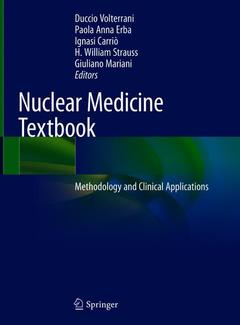Nuclear Medicine Textbook, 1st ed. 2019 Methodology and Clinical Applications
Coordonnateurs : Volterrani Duccio, Erba Paola Anna, Carrió Ignasi, Strauss H. William, Mariani Giuliano

Building on the traditional concept of nuclear medicine, this textbook presents cutting-edge concepts of hybrid imaging and discusses the close interactions between nuclear medicine and other clinical specialties, in order to achieve the best possible outcomes for patients.
Today the diagnostic applications of nuclear medicine are no longer stand-alone procedures, separate from other diagnostic imaging modalities. This is especially true for hybrid imaging guided interventional radiology or surgical procedures. Accordingly, today?s nuclear medicine specialists are actually specialists in multimodality imaging (in addition to their expertise in the diagnostic and therapeutic uses of radionuclides).
This new role requires a new core curriculum for training nuclear medicine specialists. This textbook is designed to meet these new educational needs, and to prepare nuclear physicians and technologists for careers in this exciting specialty.Fundamentals of natural and artificial radioactivity.- Ionizing radiations and their interaction with matter.- General design of radiopharmaceuticals.- Pathophysiology of organs/diseases as it relates to radiopharmaceuticals’ uptake.- Single-photon emitting radiopharmaceuticals.- Positron-emitting radiopharmaceuticals Radiopharmaceuticals for therapy.- Radiopharmacy/radiochemistry for single-photon emitting and for therapeutic radiopharmaceuticals.- Radiopharmacy/radiochemistry for positron-emitting radiopharmaceuticals.- Methods and instrumentation for measuring radioactivity.- General-purpose and dedicated gamma cameras.- Image acquisition and processing with gamma cameras (including SPECT/CT and dedicated gamma cameras).- Quality control of gamma cameras.- Principles of PET imaging.- Principles of CT imaging.- Principles of MR imaging.- PET/CT and PET/MR tomographs.- Image acquisition and processing with PET/CT and PET/M.- Quality control of PET/CT and PET/MR tomographs.- Essentials of CT image interpretation.- Essentials of MR image interpretation.- General principles of radionuclide therapy in oncology.- Radiation protection for patients, personnel, and the environment.- Principles of radiation biology and dosimetry for nuclear medicine procedures.- Hybrid imaging and radionuclide therapy of skeletal diseases.- Hybrid imaging of the cardiovascular system.- Hybrid imaging of pleuro-pulmonary diseases.- Hybrid imaging of the Central Nervous System.- Hybrid imaging of infection/inflammation.- Hybrid imaging of the gastrointestinal tract.- Hybrid imaging and radionuclide therapy of the liver and biliary tract.- Hybrid imaging and radionuclide therapy in endocrinology.- Hybrid imaging and radionuclide therapy of neuroendocrine tumors.- Hybrid imaging of the lymphatic system.- Radioguided surgery.
Duccio Volterrani, MD, is an Associate Professor of Nuclear Medicine and current Director of the Nuclear Medicine Division of the University Hospital of Pisa and of the Post-Graduate Specialty School in Nuclear Medicine of the University of Pisa (Pisa, Italy). He is a former member of the Board of Directors of the Italian Association of Nuclear Medicine, and his main interests in Nuclear Medicine are: neurology, oncology, and nephro-urology.
Paola A. Erba, MD, PhD, is an Associate Professor of Nuclear Medicine at the University of Pisa (Pisa, Italy). She is a member of the Committee on Infection and Inflammation of the European Association of Nuclear Medicine, and her main interests in Nuclear Medicine include: oncology, infection/inflammation; development of new radiopharmaceuticals for both diagnosis and therapy; biological markers of disease; imaging infection with new molecular imaging agents; and the development of new radioimmunoconjugates for molecular radiotherapy.
Ignasi Carriò, MD, is a Professor of Nuclear Medicine at the Autonomous University of Barcelona and Director of the Department of Nuclear Medicine at Hospital Sant Pau in Barcelona (Spain). He has been Editor-in-Chief of the European Journal of Nuclear Medicine and Molecular Imaging (2004-2018). He was a Past-President of the European Association of Nuclear Medicine. He has published over 200 original articles in International peer-reviewed journals, his main interests in Nuclear Medicine focusing on the applications of radionuclide-based procedures in cardiology, neurology, oncology.
H. William Strauss, MD, is a Professor of Radiology at Cornell University’s Weill School of Medicine, New York (NY, USA) and an Attending Physician Emeritus, Molecular Imaging and Therapy Service, Memorial Sloan Kettering Cancer Center (New York). He has previously served as a Professor of Radiology and Director of Nuclear Medicine, Massachusetts General Ho
Date de parution : 08-2019
Ouvrage de 1331 p.
21x27.9 cm



